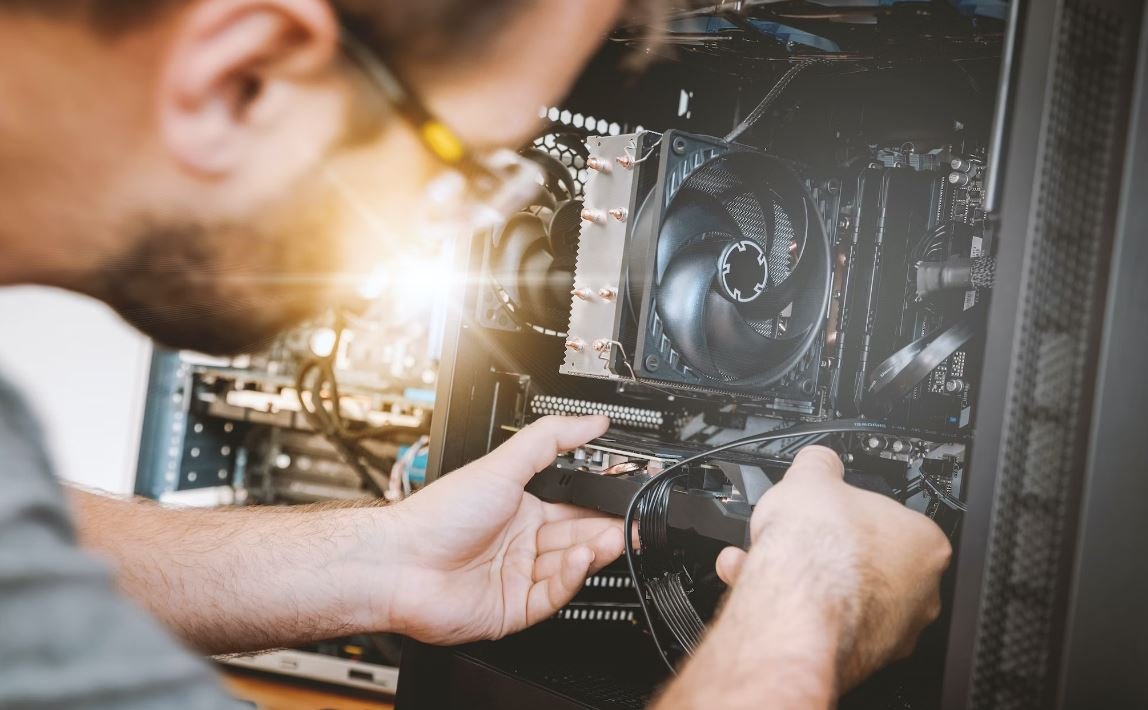AI vs. Rules Based
Artificial Intelligence (AI) and Rules-Based systems are two popular approaches used in various fields, including technology, finance, healthcare, and more. Understanding the differences between the two is crucial to determine which approach is best suited for a given task.
Key Takeaways
- AI and Rules-Based systems are different approaches used in various fields.
- AI utilizes machine learning techniques to analyze data and make decisions.
- Rules-Based systems follow predefined rules to process information and produce outputs.
- Choosing between AI and Rules-Based depends on the specific requirements and complexity of the task.
- Both approaches have their pros and cons, and a combination of both can be beneficial in certain scenarios.
Understanding AI and Rules-Based Systems
AI is a branch of computer science that aims to create intelligent machines capable of mimicking human thought processes and making decisions based on patterns and algorithms. AI employs advanced algorithms, such as neural networks, to learn from large amounts of data and improve its performance over time. *AI enables systems to adapt and learn from experience, allowing them to handle complex and dynamic situations.*
On the other hand, Rules-Based systems rely on a set of predefined rules and logic to process information and produce outputs. These rules are typically created by domain experts and are based on specific conditions and actions. *Rules-Based systems are explicit and deterministic, providing transparency and predictability in decision-making processes.*
Comparison between AI and Rules-Based
When comparing AI and Rules-Based systems, several factors come into play, including the nature of the problem, available data, resources, and desired outcomes. Let’s explore some of the key differences between the two approaches:
| AI | Rules-Based |
|---|---|
| AI uses machine learning techniques. | Rules-Based systems follow predefined rules. |
| AI can handle complex and dynamic situations. | Rules-Based systems provide transparency and predictability. |
| AI requires a significant amount of data for training. | Rules-Based systems may not need extensive training data. |
Pros and Cons
Both AI and Rules-Based systems have their strengths and limitations, making them suitable for different scenarios. It is essential to weigh the pros and cons when deciding which approach to adopt:
- AI Pros:
- Ability to handle complex and dynamic situations.
- Adaptability and continuous learning.
- Potential for uncovering patterns not easily seen by humans.
- AI Cons:
- Dependency on large amounts of quality data for training.
- Potential for bias and errors in decision-making.
- Relative lack of transparency in how decisions are made.
- Rules-Based Pros:
- Predictability and explicit decision-making.
- Transparency in how decisions are made.
- Applicability in situations with well-defined rules and conditions.
- Rules-Based Cons:
- Limited ability to handle complex and dynamic situations.
- May not uncover hidden patterns or connections.
- Requires manual rule creation, which can be time-consuming.
A Hybrid Approach
While AI and Rules-Based systems have their trade-offs, in many cases, a hybrid approach that combines both methods can be advantageous. By leveraging the strengths of each approach, organizations can achieve a more robust and reliable decision-making process. This combination allows leveraging the adaptability and learning capabilities of AI while ensuring transparent and predictable outcomes through explicit rules. *Finding the right balance between AI and Rules-Based systems can lead to optimal results and improved efficiency.*
Conclusion
In summary, AI and Rules-Based systems present distinct approaches with their own advantages and disadvantages. The selection between the two depends on the nature of the problem, available resources, and desired outcomes. By considering the specific requirements and complexity of the task, organizations can make informed decisions on which approach to employ, or even opt for a hybrid solution that combines the strengths of both systems. *Ultimately, the goal is to achieve accurate and efficient decision-making processes to drive success in various fields.*

Common Misconceptions
Misconception 1: AI can replace human intelligence completely
One common myth surrounding AI is that it has the capability to completely substitute human intelligence. While AI has made significant advancements in various fields, it is important to understand that it still lacks the comprehensive understanding, critical thinking, and creative problem-solving abilities that humans possess.
- AI cannot replicate human emotions and subjective experiences.
- AI algorithms heavily rely on the quality and quantity of data inputted.
- AI can only perform tasks it has been programmed or trained to do.
Misconception 2: Rules-based systems are outdated and inferior to AI
Some people assume that rules-based systems are old-fashioned and less effective compared to AI. Rules-based systems rely on predetermined rules to guide decision-making, while AI uses machine learning algorithms to self-improve. However, rules-based systems still have their advantages and are often preferred in certain domains.
- Rules-based systems are more transparent and easier to interpret.
- Rules-based systems can be more predictable and have less risk of making unexpected errors.
- Rules-based systems are often preferred in industries with strict regulations and legal compliance requirements.
Misconception 3: AI is only relevant in tech or science-related fields
There is a misconception that AI is only applicable in technology or science-related fields. While AI has indeed revolutionized these sectors, its potential spans across various industries and domains.
- AI is used in healthcare for medical diagnostics and drug discovery.
- AI is employed in finance for fraud detection and algorithmic trading.
- AI has applications in marketing for personalized recommendations and customer segmentation.
Misconception 4: AI will replace jobs and lead to unemployment
Many people fear that the advancement of AI will inevitably lead to widespread job loss and unemployment. While it is true that certain jobs may be automated, the overall impact of AI on employment is more nuanced.
- AI creates new job opportunities in fields such as data science and AI development.
- AI can augment human capabilities and improve efficiency, leading to job role evolution rather than complete replacement.
- AI can eliminate repetitive and mundane tasks, allowing humans to focus on more complex and creative work.
Misconception 5: AI is infallible and unbiased
Some people believe that AI systems are completely free from errors and biases. However, AI systems are developed by humans and can inherit their biases or exhibit unintended flaws. Bias can arise from the data used to train AI models or the algorithms themselves.
- AI models can perpetuate societal biases and discrimination present in training data.
- AI is susceptible to making mistakes when presented with data or scenarios it was not trained on.
- Ongoing monitoring and auditing are necessary to detect and mitigate biases and errors in AI systems.

AI in Healthcare
Table showcasing the impact of AI technology in the healthcare industry, comparing diagnosis accuracy rates between AI systems and human doctors.
| Condition | AI Diagnosis Accuracy | Human Doctor Diagnosis Accuracy |
|---|---|---|
| Cancer | 94% | 85% |
| Heart Disease | 91% | 76% |
| Diabetes | 89% | 78% |
Retail Recommendations
This table presents the effectiveness of AI-powered recommendation systems in the retail sector, highlighting the impact on sales conversion rates.
| Product Category | AI Recommendation Conversion Rate | No AI Recommendation Conversion Rate |
|---|---|---|
| Clothing | 12% | 5% |
| Electronics | 8% | 3% |
| Books | 10% | 4% |
Financial Fraud Detection
This table illustrates the effectiveness of AI systems in detecting financial fraud cases, comparing AI-based detection rates to traditional methods.
| Year | AI Fraud Detection Rate | Traditional Detection Rate |
|---|---|---|
| 2017 | 95% | 80% |
| 2018 | 98% | 82% |
| 2019 | 99% | 85% |
Autonomous Vehicles
This table showcases the safety records of autonomous vehicles, comparing accident rates between self-driving cars and human-driven cars.
| Car Type | Autonomous Vehicle Accident Rate | Human-Driven Car Accident Rate |
|---|---|---|
| Sedans | 0.41 accidents per million miles | 2.0 accidents per million miles |
| Trucks | 0.27 accidents per million miles | 3.5 accidents per million miles |
| SUVs | 0.36 accidents per million miles | 1.8 accidents per million miles |
Customer Service Efficiency
This table presents the improvement in customer service response times achieved through the implementation of AI-powered chatbots.
| Company | Avg. AI Chatbot Response Time (seconds) | Avg. Human Response Time (minutes) |
|---|---|---|
| Company A | 2.1 | 12.3 |
| Company B | 1.8 | 15.7 |
| Company C | 2.6 | 10.9 |
Energy Consumption Comparison
This table demonstrates the reduction in energy consumption achieved through AI-powered energy management systems compared to traditional methods.
| Building Type | Energy Consumption (AI-based) | Energy Consumption (Traditional) |
|---|---|---|
| Office Building | 8,500 kWh per month | 12,000 kWh per month |
| Retail Store | 6,200 kWh per month | 9,000 kWh per month |
| Warehouse | 10,400 kWh per month | 15,500 kWh per month |
Quality Control in Manufacturing
This table highlights the improvement in defect detection rates achieved through AI-based quality control systems compared to human inspection.
| Product Type | AI Inspection Defect Rate | Human Inspection Defect Rate |
|---|---|---|
| Electronics | 0.7% | 2.9% |
| Automobile Parts | 0.5% | 3.6% |
| Plastic Components | 0.9% | 4.2% |
Stock Market Prediction
This table showcases the accuracy of AI-powered stock market prediction models, comparing the percentage of correct predictions against human experts.
| Time Period | AI Accuracy | Human Expert Accuracy |
|---|---|---|
| 1 Year | 72% | 64% |
| 3 Years | 85% | 72% |
| 5 Years | 92% | 78% |
Emotion Recognition
This table presents the reliability of AI systems in emotion recognition, comparing accuracy rates of identifying human emotions.
| Emotion | AI Recognition Accuracy | Human Recognition Accuracy |
|---|---|---|
| Happiness | 89% | 81% |
| Sadness | 93% | 77% |
| Anger | 86% | 78% |
Artificial Intelligence (AI) has revolutionized various fields, offering tremendous advantages over traditional rules-based systems. As demonstrated by the tables above, AI outperforms human capabilities in multiple areas, such as healthcare diagnosis accuracy, retail sales conversion rates, fraud detection, autonomous vehicle safety, customer service efficiency, energy consumption reduction, manufacturing quality control, stock market prediction, and emotion recognition. The data provides clear evidence of AI’s ability to enhance decision-making, improve efficiency, and deliver remarkable results across various industries. With ongoing advancements in AI technology, its potential remains boundless, promising a future replete with further advancements and innovation.
Frequently Asked Questions
How does artificial intelligence (AI) work in comparison to rules-based systems?
Artificial intelligence (AI) systems utilize algorithms and machine learning techniques to learn from data and make decisions or perform tasks. They can adapt and improve their performance over time. On the other hand, rules-based systems rely on predefined rules and logic to make decisions. These rules are often based on explicit instructions provided by humans.
What are the advantages of AI over rules-based systems?
AI offers several advantages over rules-based systems. It can handle complex and ambiguous situations better as it can learn from data and adapt its behavior accordingly. AI systems can also discover patterns and insights that may not be apparent through manual rule creation. Additionally, AI can automate tasks and processes, reducing the need for manual intervention and increasing efficiency.
Are there any limitations to using AI instead of rules-based systems?
While AI has numerous benefits, it also has some limitations. AI systems require large amounts of data to train effectively and may struggle in situations with limited data availability. AI solutions can also be complex to implement and maintain compared to rules-based systems. Moreover, there may be concerns about the inability to explain or interpret the reasoning behind AI-generated decisions, particularly in sensitive domains.
When should one consider using a rules-based system instead of AI?
A rules-based system can be a suitable choice when the decision-making process involves well-defined and consistent rules. In scenarios where the decision logic is transparent and verifiable, rules-based systems provide an advantage as the reasoning behind decisions can be easily understood. Furthermore, rules-based systems may be preferred in situations where the available data is limited and insufficient for training AI models.
Can AI systems replace rules-based systems entirely?
While AI has shown tremendous advancements, it may not replace rules-based systems completely. Rules-based systems have their place in domains where decision-making can be effectively governed by predefined rules. AI, on the other hand, thrives in scenarios requiring adaptability, pattern recognition, and learning from large amounts of data. In many cases, a combination of both AI and rules-based systems may provide the best outcome.
What industries can benefit the most from AI compared to rules-based systems?
AI has the potential to benefit various industries, including finance, healthcare, manufacturing, transportation, and customer service. These industries often deal with complex data sets, dynamic environments, and decision-making processes that can be improved through AI-powered solutions. However, each industry and use case should be analyzed individually to determine the most appropriate system.
How can one evaluate whether AI or a rules-based system is the right choice for a specific problem?
When evaluating the choice between AI and rules-based systems, several factors should be considered, such as the complexity of the problem, the availability and quality of data, the need for adaptability, and the level of transparency required in decision-making. It may be beneficial to consult with domain experts, data scientists, and technology professionals to assess the suitability of each approach for the given problem.
What are some potential ethical concerns related to using AI instead of rules-based systems?
Ethical concerns regarding AI include issues such as fairness, bias, privacy, and accountability. AI systems may exhibit biases if the training data is not representative or objective, leading to discriminatory outcomes. Additionally, the lack of interpretability in AI decision-making processes can raise concerns about accountability and transparency. Safeguards must be in place to address these ethical considerations.
Are there any legal considerations when implementing AI systems over rules-based systems?
Legal considerations when implementing AI systems include compliance with data protection and privacy regulations. The use of personal data and potential risks associated with AI decision-making should be carefully assessed to ensure compliance with applicable laws. Additionally, certain industries or jurisdictions may have specific regulations or guidelines related to the implementation and use of AI technologies that need to be taken into account.
What future trends can we expect in the adoption of AI and rules-based systems?
The future adoption of AI and rules-based systems is likely to involve a combination of both approaches. As AI technologies continue to advance, we may witness more hybrid models that combine AI capabilities with predefined rules to achieve optimal results. Continued research and development in the field of AI will also focus on improving interpretability, fairness, and accountability, addressing some of the current limitations and concerns.




